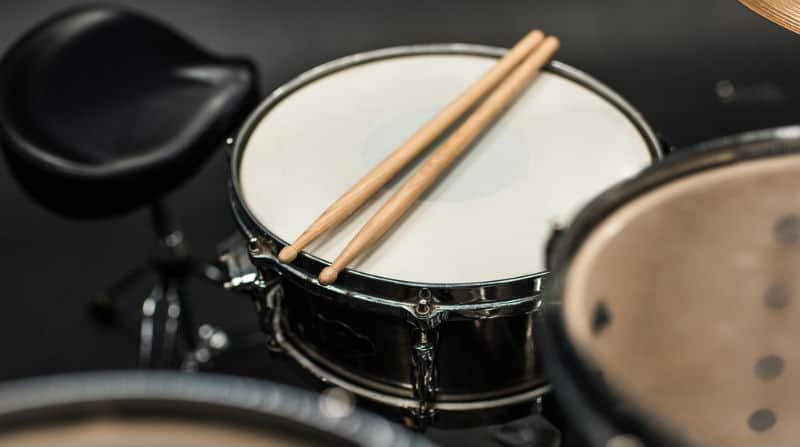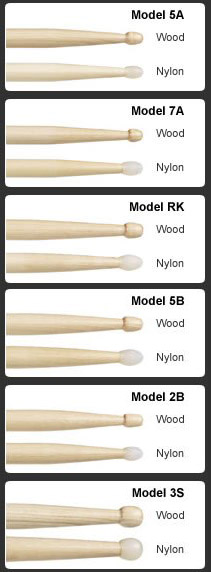Last Updated on June 4, 2021 by Danny
Drumsticks are a recurring and ever-existing expense for drummers. A pair of quality drumsticks is crucial to getting the most out of your drum kit. A pair of typical wooden drumsticks usually don’t last over a month. In this article, we breakdown the various factors affecting the price of drumsticks and give you an idea of how much you will have to spend to get the best pair for you.
How much are Drum Sticks
An average drumstick will cost between $4 and $8. Quality drumsticks, however, can cost $10 and over per pair. A pair of cheap drumsticks will cost less than $3, and if you are willing to buy in bulk, they might end up costing only around a dollar a pair.
However, it is best to avoid these cheap ones as neither they do last long nor sounds good. If you get stuck between choosing a pack of 10 cheap drumsticks or just one pair of premium drumsticks, we suggest that you go with the premium pair. That is because the single premium pair will last nearly as long as the ten cheap ones combined and will sound and feel way better.
While we have stated the standard cost of drumsticks above, they can fluctuate significantly based on various factors, ranging from their materials to their size. Read further on to understand these better.
Factors Affecting Drumstick Price and Performance
Material
The material is one of the most important factors when it comes to price. Today you can find drumsticks made with various materials, from simple wood to even carbon fiber.
As you can guess, wood is the most common material used to make drumsticks. Manufacturers use many different kinds of wood to produce drumsticks, but the most common ones are hickory, maple, and oak. Hickory is the most commonly used material due to its balance between weight, strength, and density. Maple is a little rare. The shells are ideal for fast play and low volume as it is very light. Oak is the most premium of wooden drum sticks and is the densest of these three. That makes oaks drumsticks much more durable and suited for heavy hitters. Among all oak drumsticks, Japanese white oak drumsticks tend to be among the most expensive due to the trees’ rarity.

Aluminum drumsticks have also been gaining popularity lately. They have many benefits over wooden drumsticks, including increased durability, faster rebounds, perfect balance, and reduced vibration in hand. An alluvium drumstick can last as long as six wooden drumsticks. However, aluminum drumsticks are more expensive than wooden drumsticks.
However, the most expensive drumsticks made from carbon fiber can cost even above $20 a pair. Carbon fiber drumsticks are incredibly durable, even more so than aluminum. They have more flexibility than aluminum. If you want premium drumsticks that will stand out from the crowd and last for a long time, then carbon fiber drumsticks are for you.
Size

Drumsticks are classified into light, medium, and heavy as per size. The size and thickness are designated by a number( between 2 and 9). The smaller the number thicker the drumstick. The number is followed by a letter that indicates the model of the drumstick. For example, an 8B drumstick is much thinner than a standard drumstick and therefore lighter. That makes it suitable for jazz music. On the other hand, a 2B drumstick is vast and best suited for the metal genre and the drum corps. While there might be small differences in price between sizes, they are not significant.
Tip
The shape of the tip doesn’t affect the price but has a significant effect on the sound. The standard shapes of tips are oval, round, barrel, arrow, Taj Mahal, and teardrop. The rule with the shapes is that the smaller the area that touches the drums, the more defined it is. For example, a barrel tip will sound more defined than an arrow tip. The only way to truly understand the differences between the tips is to try them out yourself in a local music store.
The tip is made of wood or nylon. Nylon is more expensive than wood tips, but only by a small margin. These drumsticks work best with electronic drums. Wood tips are the most common and used in all genres, but they are not as durable as nylon. Nylon lasts longer but has a different sound profile that doesn’t appeal to everyone. The cymbals sound much brighter, and this tends to limit the genres in which you can use nylon drumsticks. For example, the jazz genre doesn’t typically use nylon drumsticks.
Brand
Well, known brands of drumsticks cost significantly higher than a pair of generic drumsticks. Brands like Zildjian, Vic Firth, and Vater Percussion do charge a premium for their drumsticks. Generic drum sticks made from the same materials as these branded drumsticks will be much cheaper. That might tempt you into thinking both the branded and generic one will perform the same way. However, remember that these brands have spent years perfecting their drumsticks. They have multiple checks to ensure you get a perfect pair of appropriately balanced and shaped drumsticks. You cannot expect this high level of quality control with unbranded or unknown brands of drumsticks.
Check out some of the best-selling drumsticks
[amazon bestseller=”drumsticks” items=”6″ template=”table”]Conclusion:
As with any item, buying drumsticks in bulk will save you a significant amount of money in the long run. As a drummer, you would need plenty of drumsticks over the years, so buying them beforehand is a smart idea. Drumsticks don’t have an expiry date to store them for prolonged periods and don’t take up much space. You will also be saving a lot of your time and energy as you won’t have to visit your local music shop every time your drumsticks break.
If the drumsticks you buy have some innovation or rare feature, you will have to pay a premium for those. An example would be Zildjian’s anti-vibe drumsticks. These drum sticks have a tiny rubber piece inserted into a hole drilled in the lower edge. That helps reduce vibrations and makes them ideal for electronic drums. They are more challenging than acoustic kits and tend to vibrate more.